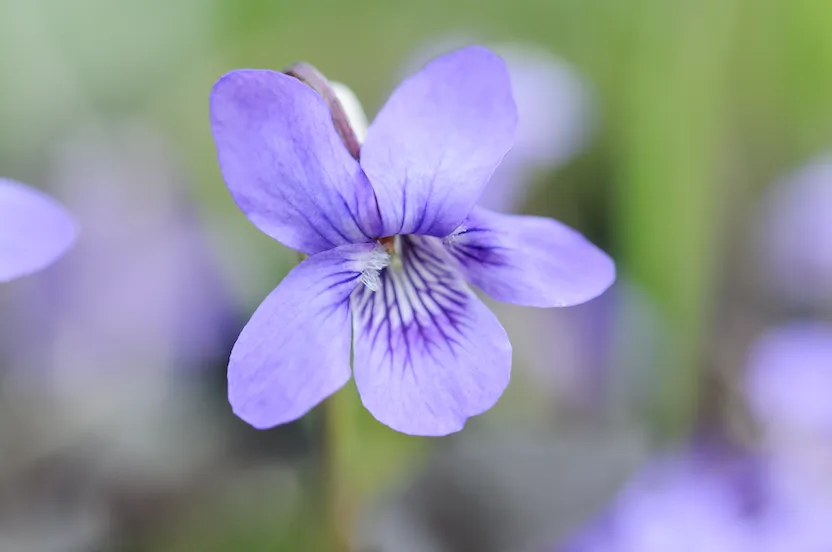My favourite gardens have no borders. Instead, plants grow in swathes of meadow-like colour and texture. It’s only the pathways and the occasional seat, clipped hedge or mossy urn that reminds me I’m in a garden. The hand of the gardener is invisible and wildflowers flourish, often growing intermingled with garden perennials. A single wildflower can look fragile, but when grown en masse they exert a powerful presence.
Taking lessons from nature
When designing with plants that are native or naturalised in Britain my first inspiration is the way they grow in the wild; their conditions, their companions and their pattern of distribution and flowering succession. Wildflower plantings require sensitive management and an editing eye, but they also need creativity, and a willingness to experiment and to learn from both triumphs and failures.
Wildflowers thrive in harsh conditions where competitive grasses are at a disadvantage; poor soil, cracks between stones and extreme damp are examples of niche habitats where certain species will flourish. Low-growing, sun-loving species such as Sedum acre, thymes (especially Thymus praecox and Thymus pulegioides), Dianthus deltoides and Armeria maritima will create successions of colour between paving stones or in the nooks of walls.

Ajuga reptans, Viola reichenbachiana, Viola riviniana, Viola odorata, wood anemone (Anemone nemorosa), Common dog violet, Viola riviana and the delicate grass Melica uniflora are great options for creating a low carpet in shaded woodland corners.
Opportunist pioneer species love well-drained, gritty soil and sun. The slender spires of yellow Reseda luteola look magnificent growing in great swathes alongside the rich blue of Echium vulgare. Both species need space for their architecture to be appreciated and need deadheading to be kept under control.

Using wildflowers in your borders
Within sunny perennial borders, I grow purple-pink strains of Daucus carota and Centaurea nigra, an excellent nectar plant that flowers for up to eight weeks.

Cow parsley (Anthriscus sylvestris) looks beautiful but you need to be vigilant about cutting the stems down before it self-seeds, and divide it before clumps get too large. The annual, occasionally biennial, Torilis japonica is similar to cow parsley but shorter with finer leaves and flowers from July to September. It’s a good mixer as it’s erect and airy and will stand up alone.
Tussock-forming grasses are easier to combine with perennials, as they won’t send out spreading, competitive roots. Deschampsia cespitosa’s evergreen tussocks suppress weeds, making it ideal for colonising wilder areas. It’s relatively short-lived, so remove old plants that are starting to die back and in their place plant species such as Leucanthemum vulgare. I add Molinia caerulea for upright, luminous accents and the devil’s-bit scabious (Succisa pratensis) for its late-summer flowers.

Observing and growing wildflowers encourages you to think imaginatively at both macro and micro scales. The humble ox-eye daisy and knapweed, grown en masse, can be as exciting as singular specimens of the obscure, tall, pink corncockle or the internationally rare, broad-leaved cudweed (Filago pyramidata).
Ideas for meadow-style plantings
Wildflowers are all around us so there’s never a shortage of inspiration, from celebrated botanical sites and nature reserves to anonymous roadside verges and railway cuttings. Take cues and inspiration for what species to grow from the plants that grow abundantly in your local area. Wildflowers have a reputation for being fickle, so start with small trial patches to see what is likely to be achievable.
Sow yellow rattle (Rhinanthus minor) in the autumn to increase diversity. The root of this annual is a hemiparasite on grass and once established it can reduce the vigour of the grass by up to 50 per cent, which can encourage a greater display of wildflowers.
A meadow garden is more about sensitive management than conventional gardening. If you’re lucky enough to have sufficient space to create a sizeable meadow, you’ll need to give some consideration to how you will get your meadow cut, and raked. It’s best to mow your meadows patch by patch at different times of year to increase biodiversity; tackling the most grassy and fertile areas first. Local meadow conservation groups are invaluable for providing support for wildflower meadow conservation services and contacts for the contractors cutting it.
How to succeed with wildflowers in grass - use plant plugs
Wildflower plug plants are now widely available and can be an easier way to introduce wildflowers to your garden. Here's a few tips to help ensure success.
- Planting plugs into an established, dense grassy sword is unlikely to be successful. Equally, you cannot just sow wildflower seed into an area of established grass. It simply will not work – the grass will out-compete any seedlings.
- Cut the grass as low as you can get it. Remove any organic matter such as thatch or moss, as you need to get the plugs into contact with the soil.
- The best time to plant your wildflower plugs is from autumn to late spring, when the ground is cool and damp.
- Plant at random intervals (five per square metre) to achieve a naturalised look.
You can hear Sarah Price talk with editor Stephanie Mahon in her recent podcast for our Talking Gardens series.








